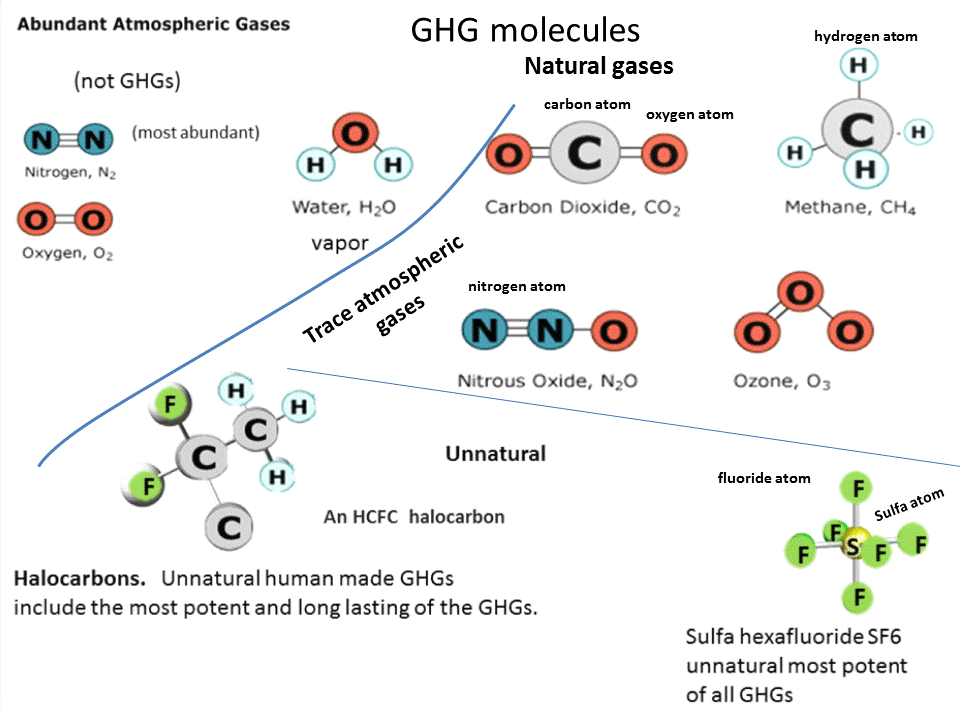
Climate Change Knowlege
Greenhouse Gases (GHGs)
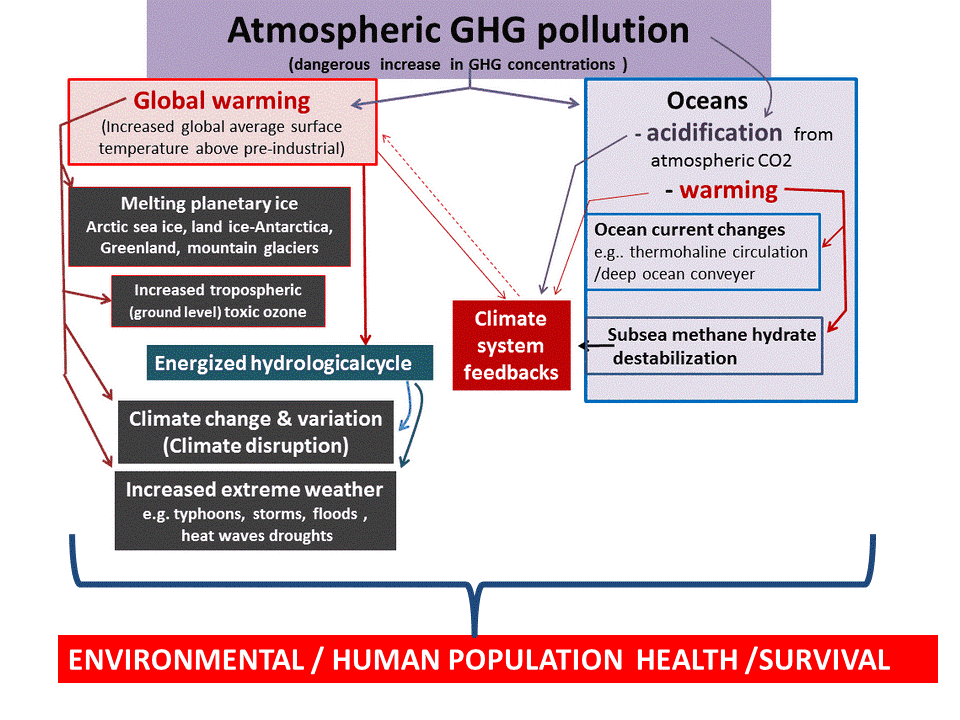
Greenhouse gas pollution
Heat radiating atmospheric trace 'greenhouse' gases are now pollutants as the US EPA 'endangerment finding' states. As with any pollutant there are number of things we must know about them. For most pollutants it is their concentration that makes them dangerous i.e. pollutants. Routinely we must a number of things about any dangerous pollutant.
Greenhouse Gas Online. By a GHG scientist. Only site dedicted to all GHGs

Essentially the science of global warming and climate change is the science of GHGs.
Know GHGs and you know all you really need to on climate change.
Greenhouse gases regulate the surface temperature of Earth and the energy of the biosphere.
Too much GHG in the atmosphere will overheat the biosphere.
Atmospheric residence time (lifetime) of a GHG
The GHGs vary by the time they last in the atmosphere called their atmospheric residence time.
CO2 is given a mean residence time of 100 years and the residence times of the GHGs are adjusted for their heating effect over 100 years.
Methane lasts in the atmosphere only about 12 years (still a long lasting GHG).
Nitrous oxide lasts about 100 years
Water Vapour
The GHG with the greatest warming effect is water vapour. It is the top GHG because of its great abundance in the atmosphere. It is not an emission but it is increased by GHG emissions. This is because water vapour increases with global warming. Warmer air holds more water vapour.
This is a positive (bad for us) feedback effect response to global warming. More global warming > more water vaour> more global warming. In this way water vapour amplifies the global warming effect of GHG emissions. The water vapour feedback is estimated to about double the global warming caused by the emission of a GHG. This amplification is taken into account in calculating the global warming potential capacity (the heating capacity of a GHG).
These are the GHGs
Naturally occurring GHGs
- Water vapour (H2O) - not counted as an emission.
- Carbon dioxide (CO2)
- Methane (CH4)
- Nitrous oxide (N2O)
- Tropospheric (ground level) ozone(O3)
Unnaturally occurring manufactured or industrial bi-product GHG chemicals,
All present in the most minute amounts.
They include the most potent GHGs and the longest lasting GHGs.They are mostly the halocarbons, the best known of which are the stratospheric ozone depleting CFCs.
Atmospheric concentration of a GHG
Water vapour has the largest concentration
CO2 has the greatest direct global warming contribution of the emissions. This is because its natural concentration is much the highest measured in parts in parts in million (parts of air).
Its emissions also OCEAN ACIDIFICATION
Its emissions also OCEAN ACIDIFICATION
Methane is next global warming contribution. It is present in parts per billion in the atmosphere.
Nitrous oxide comes next in contribution also present in parts per billion.
Global warming potential of a GHG
The atmospheric heating effect of the various GHGs varies.
The scientists estimate the global warming potential (GWP) of the GHGs by comparison with the main GHG emission CO2 over a certain period of time and give CO2 a warming potential of 1.
Over 20 years it is about 70.
Over 10 years it is 100
(Exeter Dangerous Climate Change conference 2005. Copenhagen Methane Consensus Project 2009).
Nitrous oxide is given a GWP of 300.

Smithsonian: check atmosphere/design lab for interactive simulation
Atmospheric lifetimes and global warming potentions of the three main greenhouse gases and artificial chemical GHGs that have the greatest GWP.


Atmospheric lifetimes of the
three main greenhouse gases
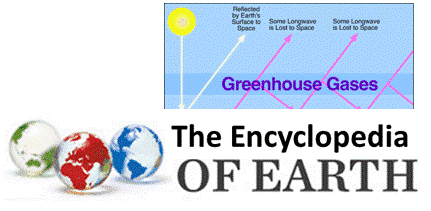
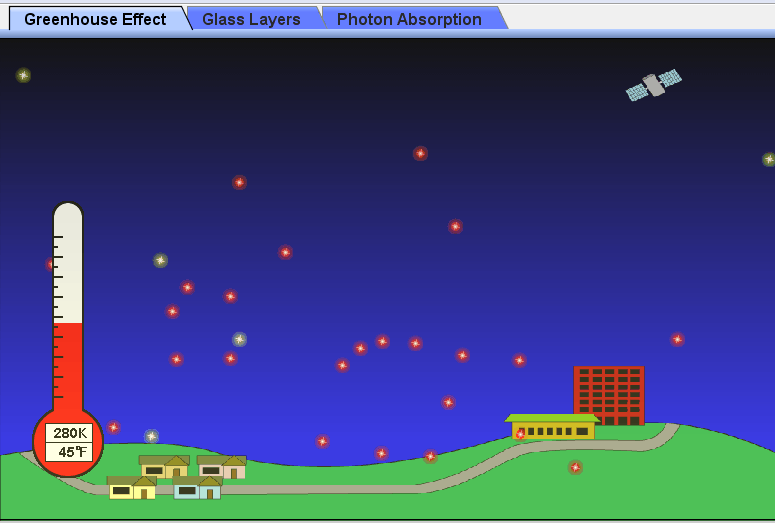
Amazing interactive simulation
Univ. Colorado
GHG molecules
The defining property of a GHG is that the GHG molecule absorbs and is energized by infrared radiation.
This is due to its very atomic structure that results in the 'dipole' effect making the molecule capable of absorbing and being energized exposure to infra red radiation. Molecular dipoles occur due to the unequal sharing of electrons between atoms in a molecule.The 3 atoms of the GHG gives it the dipole property, that the two atom abundant gases do not possess.
Atmospheric GHG molecules giving rise to the natural greenhouse (insulating) effect
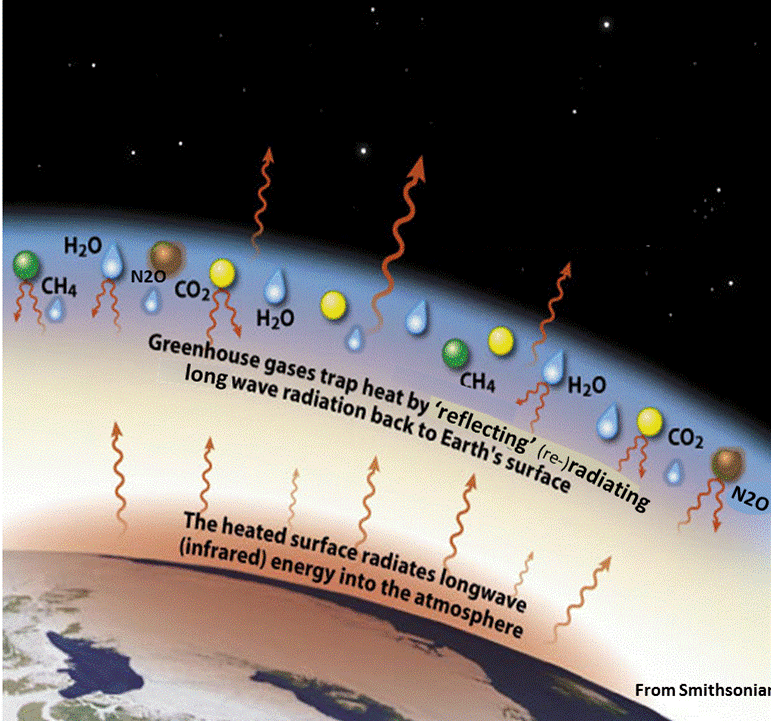
The factors that determine how much a GHG can warm the planet.
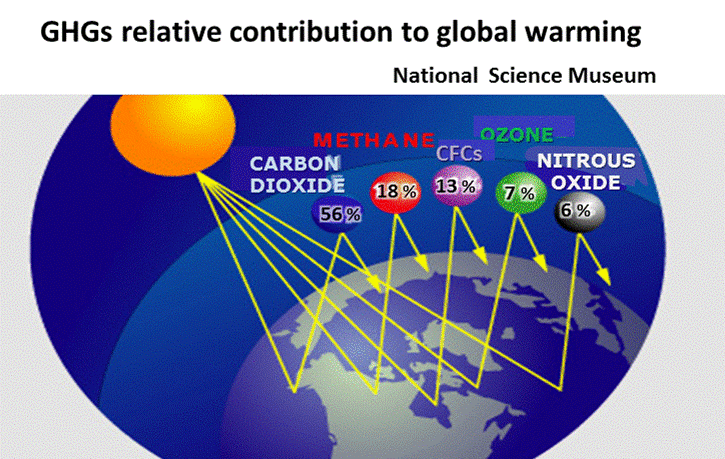
Black carbon (soot)
is a non gas greenhouse emission big global warming agent.
It may be second only to CO2 in global warming effect
It may be second only to CO2 in global warming effect
GHG science
Trace gases
GHGs are 'trace gases' in the atmosphere (measured in parts per million PPM and parts per billion PPB) and as such are powerful heat energy radaitors. If they were not present in such tiny amounts the Earth's surface would be 30C colder than it is.
Long lasting, persistent and cumulative atmospheric GHGs
In addition the main GHGs are 'long lasting' gases - making them highly persistent and cumulative.
GHGs absorb, are energized by, and actively emit Infra- red radiation
These GHG pollutants are causing increasing global warming, climate change, extreme weather events, sea level rise, and melting of planetary ice. In addition CO2 atmospheric pollution cases ocean acidification (on top of ocean warming). GHG emissions threaten the public health and welfare of current and future generations. See the report of the US EPA endangerment finding on GHGs.
- The levels that are dangerous/damaging
- The sources has a whole page.
- The rate of GHG emissions.
- How long they last
- What are the damaging effects.
- How powerful are they.
This pages covers the general science of all the GHGs.
Individual GHGs in more depth
- Carbon dioxideCO2
- Methane CH4
- Nitrous oxide N2O
- Ozone (tropospheric/ground) O3
- Halocarbons (eg. CFCs, HCFCs)
Only site dedicated to GHGs.
Run by a GHG scientist.
A few top GHG resources .
Radiative (global warming) effect.
Of the greenhouse gases that are directly affected by anthropogenic activities, carbon dioxide (CO2) has the largest total radiative effect, followed by chlorofluorocarbons (CFCs), methane (CH4), tropospheric ozone (O3), and nitrous oxide (N2O) : WMO.
